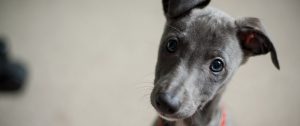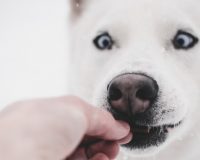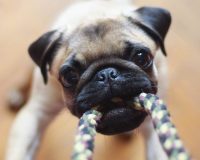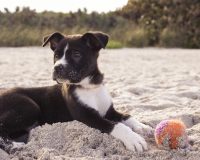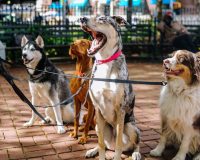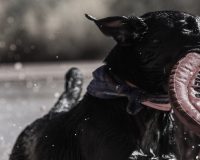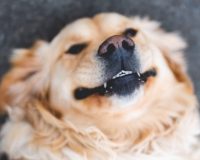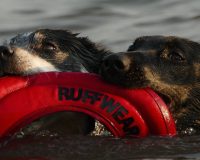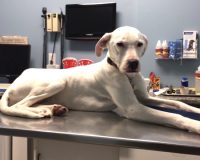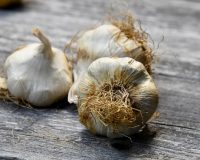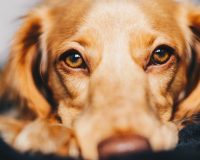All pups need projects and prefer not to be idle for long periods. They look for things to do, especially when their humans are not available. Pups are not spiteful or destructive, with any intent to burden their people. But to first-time parents, certain things pups do earns them the title of “bad dog”.
They aren’t bad dogs. In these cases, they are resourceful dogs who are meeting their needs, quite legitimately. If a perceived toy is there, it’s fair game. There is no decision on the dog’s part, no right or wrong.
In the pursuit of a project and potential snack, your new Italian leather shoes are a nearby target. They smell delicious. Leather is also animal skin, heightening interest, and they represent hours-worth of chew bliss. In that context, what pup wouldn’t get down and dirty with shoes?
Pillows and cushions dissect with certain dramatic flair, spilling their guts all over a room. And, to a dog, the leg of that heirloom end table is a stick. Basically, a great many household items are valued targets. The pup’s mission is to satisfy a very powerful need.
Insight | How to see this behaviour
Chewing and dissection are deeply wired needs that bring among the highest rewards for dogs, when satisfied. These activities are part of the predatory sequence—hard wired behaviour for preparing and eating their dinner. Chewing and dissection are a wonderful energy burner, toning the teeth and jaw and chewing soothes teething. Chewing and dissection are impossible to resist because they are so deeply rewarding.
Humans place value on things and nurture a sense of item acquisition too, but for different reasons than dogs. Heirlooms and Italian shoes have high value and financial worth to humans. Dogs, however, value things that bring them pleasure and exercise instincts.
Chewing, dissection, and lunch have high value to dogs. So any item fitting that criteria, that is available, is high value. If shoes are lying there, they are a target. If a yummy, stuffed marrow bone is sitting there, it is a target. Each has the same value to a pup: chewing, dissection and lunch.
He ate my shoe. I’m mad. Do I punish the dog?
No. You cannot teach a dog how to value your items less. Yummy is yummy. The best approach is give access to things they can value and target, and remove access to things you value. Over time and with consistent remove-redirect training on an owner’s part, the pup will default to his targets and not to yours.
Also, punishing a pup for satisfying a need is as harmful as it would be for a human. It’s completely unfair. The need doesn’t go away, so the approach is to expect it and be with an appropriate redirect. Then you’ve won, by strategy.
Remove the shoes and redirect to the bone
Because chewing and dissection are natural needs, they should be wholly encouraged and paid off. But, in the same way we don’t let children play with inappropriate items, we also want to pups to play with items that are appropriate for them. Redirecting pups to teething chews, stuffed Kongs or toys they can chew and dissect channels them in the right direction. What’s important is to let the need the need express and provide avenues to satisfy it.
At the first sign of his interest in an inappropriate item, remove and replace with a better, appropriate one that is more valuable to the pup:
> a frozen, stuffed marrow bone or Kong
> a stuffed treat ball
> treats that are wrapped in clean rags and knotted three or four times are fantastic dissection toys.
The more you make a pup work for their snacks, the more challenged and satisfied they will be. Challenge is good, as it emulates the work they are instinctively hard wired to do to acquire and consume their lunch, otherwise.
Engagement with you works too…a good game of tug of war is equally rewarding, and also connects to food, believe it or not. See our article on Tug of War for more on this.
How do you manage this when you’re not home?
Puppies, in particular, should not have access to inappropriate items while you’re away, for obvious reasons. There are several tactics a puppy parent can use to keep a puppy redirected:
• crate and ex-pen, or
• baby-gate the puppy away from your valuables, and
• give dog-appropriate chew items before leaving home
• have a walker come in twice per day for potty and play time, to help socialize and train the pup and burn more of that natural energy off.
These tactics work. They satisfy natural inclinations and tire pups out. A good, long nap follows. That’s a satisfying day well spent.
Still have questions? Ask the CDWA.


